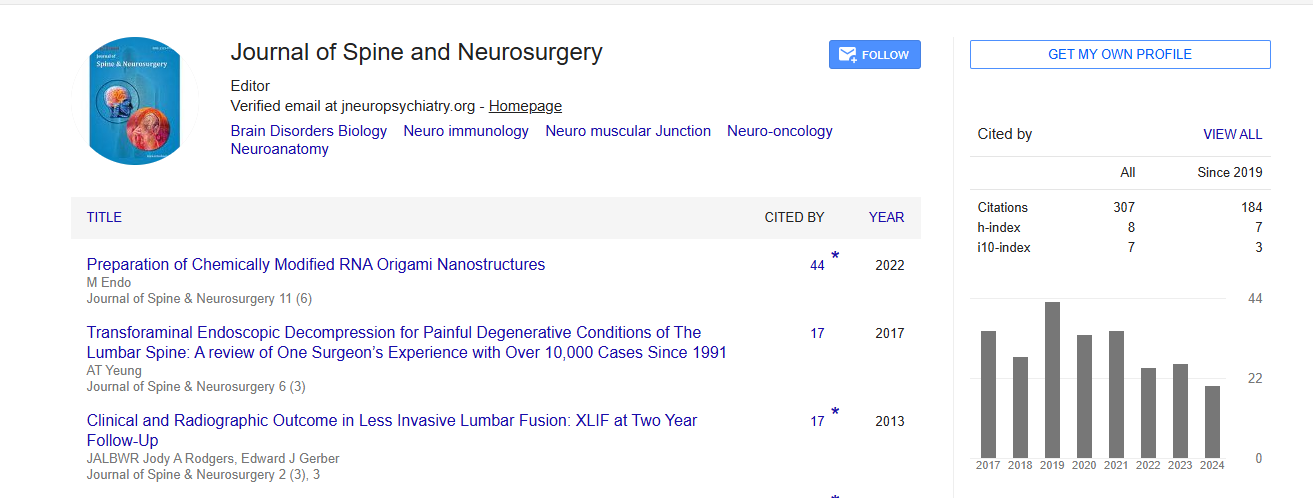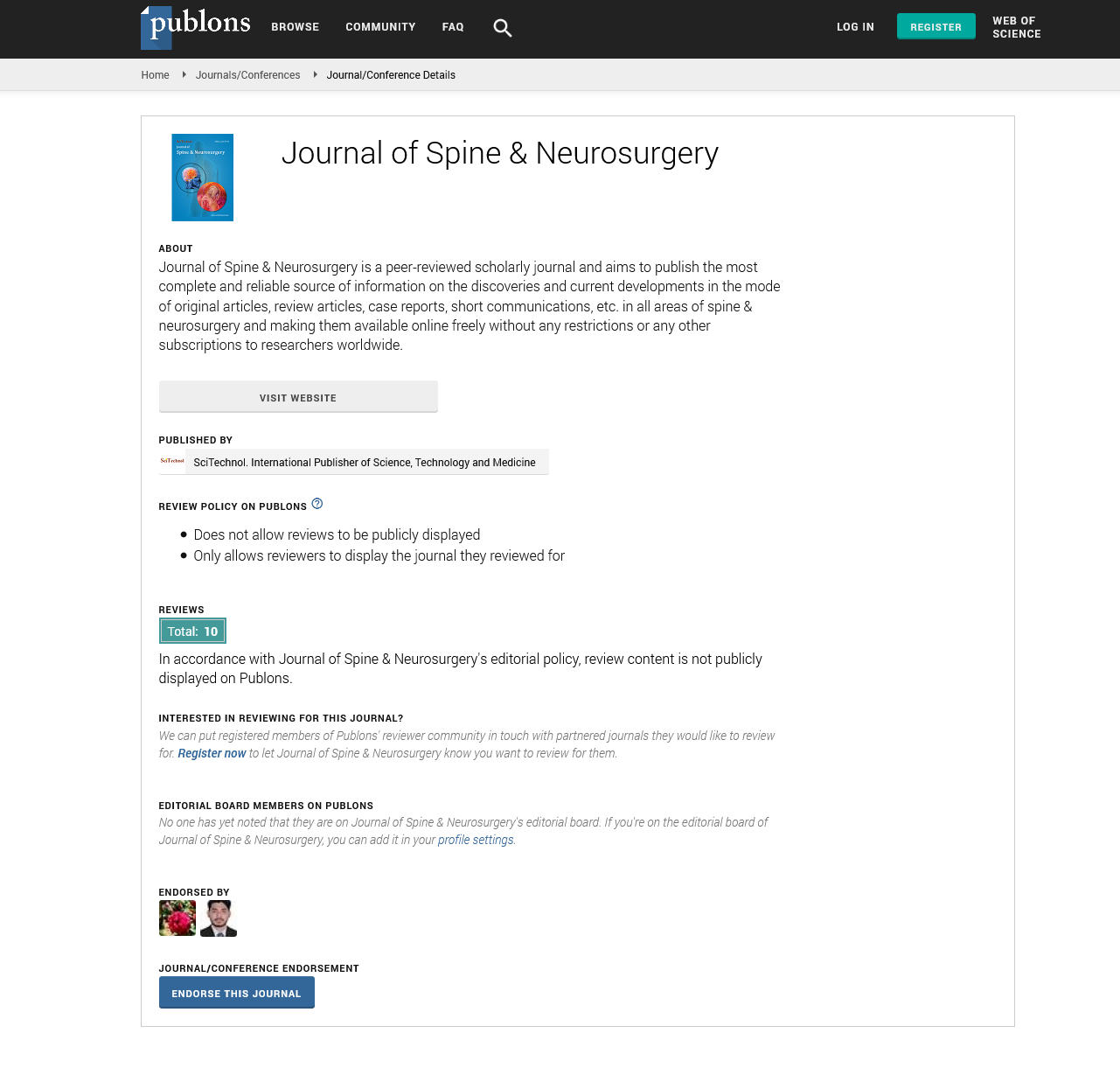Short Communication, J Spine Neurosurg Vol: 12 Issue: 6
Complexity of Polyneuritis: Causes, Symptoms, and Treatment
Spnia Sen*
1Department of Medicine, Perugia University, Perugia, Italy
*Corresponding Author: Spnia Sen,
Department of Medicine, Perugia University,
Perugia, Italy
E-mail: spnia_sen001@gmail.com
Received date: 27 November, 2023, Manuscript No. JSNS-24-128413;
Editor assigned date: 29 November, 2023, PreQC No. JSNS-24-128413 (PQ);
Reviewed date: 14 December, 2023, QC No. JSNS-24-128413;
Revised date: 21 December, 2023, Manuscript No. JSNS-24-128413 (R);
Published date: 28 December, 2023, DOI: 10.4172/2325-9701.1000192.
Citation: Sen S (2023) Complexity of Polyneuritis: Causes, Symptoms, and Treatment. J Spine Neurosurg 12:6.
Description
Polyneuritis, a term describing the inflammation of multiple peripheral nerves, is a condition that can lead to a range of symptoms affecting sensation and muscle function. Understanding the underlying causes, recognizing symptoms, and exploring treatment options are important steps in managing and modifying the impact of polyneuritis on individuals' lives [1-3]. This article delves into the complexities of polyneuritis, shedding light on its origins, manifestations, and potential avenues for treatment. Polyneuritis is characterized by inflammation that affects multiple peripheral nerves, disrupting the normal functioning of the nervous system. The inflammatory process often results in damage to the myelin sheath, the protective covering of nerve fibers, leading to impaired signal transmission between the nerves and various parts of the body.
Symptoms
Polyneuritis can have various causes, and it often occurs as a secondary condition to other underlying health issues. Common triggers include infections, autoimmune disorders, exposure to toxins or certain medications, and nutritional deficiencies. Infections such as Guillain-Barré syndrome, Lyme disease, and certain viral or bacterial infections can contribute to the development of polyneuritis [4]. The symptoms of polyneuritis are diverse and can manifest gradually or suddenly. Common indicators include weakness, numbness, tingling sensations, and pain in the affected limbs [5-7]. Muscle atrophy and a loss of reflexes may also occur. As polyneuritis progresses, individuals may experience difficulties with coordination and balance, impacting their ability to perform daily activities.
One notable form of polyneuritis is Guillain-Barre Syndrome (GBS), an autoimmune disorder where the immune system mistakenly attacks the peripheral nerves. GBS often follows an infection and can progress rapidly, leading to severe muscle weakness and, in some cases, respiratory failure [8,9]. Early recognition and intervention are crucial for managing GBS effectively.
Diagnosis and treatment
Diagnosing polyneuritis involves a comprehensive evaluation by healthcare professionals, including neurologists. Medical history, physical examinations, and diagnostic tests such as nerve conduction studies and Electromyography (EMG) help identify the extent and nature of nerve damage. Blood tests and lumbar punctures may also be conducted to rule out underlying infections or autoimmune conditions. The management of polyneuritis often involves addressing the underlying cause and alleviating symptoms. In cases where an infection is the trigger, appropriate antimicrobial medications may be prescribed [10]. Immune-modulating therapies, such as Intravenous Immunoglobulin (IVIG) or plasma exchange, are common approaches for autoimmune-related polyneuritis like Guillain-Barre syndrome. Symptomatic relief is also a key aspect of treatment, with pain management medications, physical therapy, and assistive devices playing roles in improving quality of life. Rehabilitation and occupational therapy help individuals regain strength, coordination, and independence.Conclusion
Polyneuritis, with its diverse causes and manifestations, underscores the complex nature of the nervous system. Early diagnosis, a comprehensive treatment approach, and ongoing rehabilitation are essential components of managing this condition and improving the quality of life for affected individuals. As medical research progresses, the potential for more targeted and effective interventions continues to grow, offering optimism for a better future for those contending with the challenges of polyneuritis. The prognosis for individuals with polyneuritis varies based on the underlying cause, the severity of nerve damage, and the timeliness of intervention. While some cases may resolve with appropriate treatment, others may lead to long-term neurological impairment. Rehabilitation and ongoing medical care are vital for optimizing recovery and managing persistent symptoms.
References
- Wechsler IS (1933) Etiology of polyneuritis. AMA Arch Neurol Psychiatry 29(4):813-827.
- Gilpin SF, Moersch FP, Kernohan JW (1936) Polyneuritis: A clinical and pathologic study of a special group of cases frequently referred to as instances of neuronitis. AMA Arch Neurol Psychiatry 35(5):937-963.
- Asbury AK, Arnason BG, Adams RD (1969) The inflammatory lesion in idiopathic polyneuritis. Med 48(3):173.
- McLeod JG, Walsh JC, Prineas JW, Pollard JD (1976) Acute idiopathic polyneuritis: a clinical and electrophysiological follow-up study. J Neurol Sci 27(2):145-162.
- Arnason BG, Asbury AK (1968) Idiopathic polyneuritis after surgery. Arch Neurol 18(5):500-507.
- Toyka KV, Hartung HP (1996) Chronic inflammatory polyneuritis and related neuropathies. Curr Opin Neurol 9(3):240.
- MINOT GR, STRAUSS MB, Cobb S (1933) Alcoholic polyneuritis; dietary deficiency as a factor in its production. N Engl J Med 208(24):1244-1259.
- Fisher M (1956) An unusual variant of acute idiopathic polyneuritis (syndrome of ophthalmoplegia, ataxia and areflexia). N Engl J Med 255(2):57-65.
- Buxton PH, Hayward MI (1967) Polyneuritis cranialis associated with industrial trichloroethylene poisoning. J Neurol Neurosurg Psychiatry 30(6):511.
- Leiper EJ (1946) Polyneuritis due to Gold. Br Med J 2(4464):119.
 Spanish
Spanish  Chinese
Chinese  Russian
Russian  German
German  French
French  Japanese
Japanese  Portuguese
Portuguese  Hindi
Hindi 
